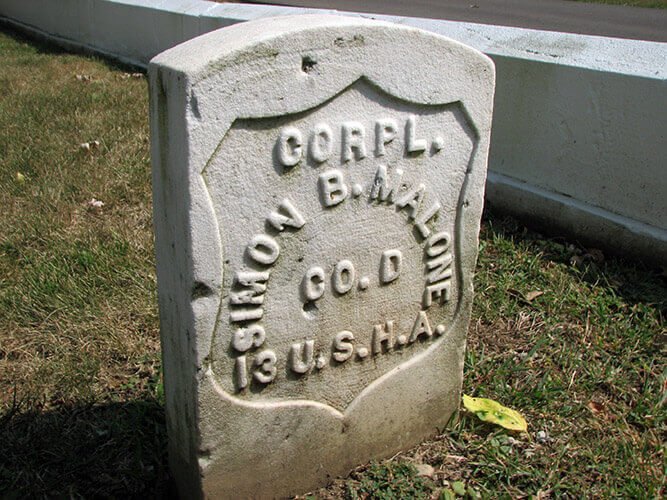Simon Booth Malone was born into slavery on December 18, 1842 in Tippah County, Mississippi. Simon came to the North as a fugitive slave after the 5th Ohio Cavalry raided his home in 1863. Sensing his chance for freedom, Simon enlisted his brother-in-law’s help in removing the log chain from around his neck. He followed the cavalry north, caring for the horses, fetching water, and providing other necessary tasks to please the Union soldiers. He made his way to Illinois and worked as a farmer until he enlisted in Company D of the 13th Regiment of the United States Colored Heavy Artillery Volunteers on March 13, 1865.
At the beginning of Civil War hostilities, many free African American men volunteered to fight but were turned away because of a law dating back to 1792 which barred African Americans from bearing arms in the U.S. Army. However as the War escalated, the need for troops increased. As a result African Americans were allowed to serve. The first of three regiments of Union African American soldiers appeared in Louisiana in 1862. In addition, the Emancipation Proclamation issued by President Abraham Lincoln on January 1, 1863 officially allowed African Americans to serve on a national scale. By war’s end, 186,000 African Americans had enlisted in the Union Army, over 1,800 of them from Illinois. Even so, their pay was far less than that of their white counterparts. Black soldiers endured racism and discrimination in their own Army because they believed a Union government would give them their best chance at achieving equality and they were willing to fight for it. The Confederate attitude toward black Union soldiers was that they were insurrectionists and were to be executed rather than taken prisoner even if wounded. It was a policy of “no quarter given.”
Simon trained at Camp Nelson, Kentucky. There is no evidence that he participated in any significant battles. Instead, Simon probably spent most of his time at garrison duty at Camp Nelson, Smithland, Lexington, and other places in Kentucky. Simon did help construct the breastwork at Fort Pillow, Tennessee. On April 12, 1864 Fort Pillow had been the site of a bloody battle in which Confederate soldiers massacred black Union troops. Confederates shot down black troops attempting to surrender; those wounded were burned or buried alive. Because of such treatment, black Union soldiers became fierce fighters with no intention of surrendering.
In June 1865 while attempting to bathe Simon and four other men were attacked by “rebels and citizens” outside of Camp Nelson. Three men were captured; Simon escaped, but burst a vein in his right leg in the process. He refused medical treatment and eventually could not march. On November 18, 1865 after approximately eight months of service Corporal Simon B. Malone was discharged from the Army for health reasons.
Afterwards, Simon moved to Godfrey, Illinois where he met and married Julia E. Dillon in June, 1867. That same year Simon and Julia moved to Normal, IL. Simon found work as a coal miner in Minonk, IL and as a wagon driver in Normal. He also hauled hay and completed other odd jobs. In about 1869 Simon purchased a home at 504 Kingsley Avenue located near the present site of Kingsley Junior High School. Records indicate that Simon and Julia had approximately nine children two of whom, Eula and Rosetta, preceded Simon in death. The effects of Simon’s leg injury increased with age and eventually forced him to seek out a disability pension. In 1880 Normal’s Postmaster Edward J. Lewis wrote a successful letter on Simon’s behalf entreating Captain William H. Hopkins to provide compensation. Lewis, a former Union officer, helped countless other veterans obtain disability pensions from the federal government and never charged a fee for his services.
At the age of 55 Julia passed away unexpectedly on the morning of January 9, 1895. Her funeral was held four days later at Mt. Pisgah Baptist Church. In the spring of 1898 at 56 years of age, Simon entered the Soldiers Home in Quincy, IL with lung disorders brought about by his war service. Later, between 1904 and 1917, Simon stayed at a home in Danville, IL. He may have also stayed in the Soldiers Home in Dayton, Ohio but it cannot be confirmed. He spent the majority of his later years in these facilities although the exact time frame cannot be established from existing records. It appears that his oldest daughter, Mary, managed the household in his absence. The last six years of his life were spent at his home in Normal.
Simon B. Malone died on January 16, 1925 at the age of 82 from the injuries he received while a soldier. Before his death, he was one of the few living members of the Charles E. Hovey post of the Grand Army of the Republic, a fraternal organization of Union Army veterans. He was buried at Evergreen Memorial Cemetery in one of the Civil War Soldiers’ sections.
Malone, Simon Booth
(December 18, 1842 — January 16, 1925)
Written by Anthony Bowman. 5 min read.
Download Full Citation Biography (0.08 MB)
How to cite this page
MLA:Bowman, Anthony. “Malone, Simon Booth.” McLean County Museum of History, 2009, mchistory.org/research/biographies/malone-simon-booth. Accessed 15 Apr. 2024. APA:
Bowman, A. (2009). Malone, Simon Booth. McLean County Museum of History, https://mchistory.org/research/biographies/malone-simon-booth Chicago:
Bowman, Anthony. “Malone, Simon Booth.” McLean County Museum of History. 2009. Retrieved from https://mchistory.org/research/biographies/malone-simon-booth